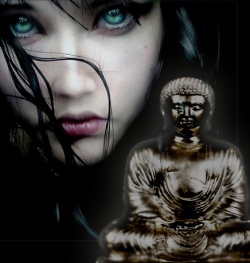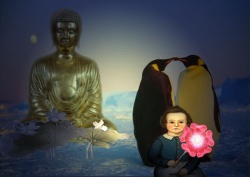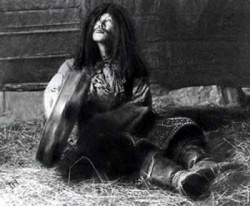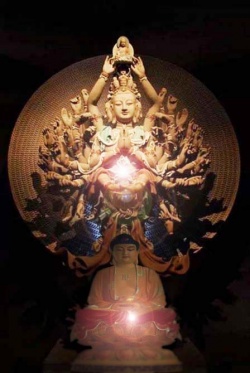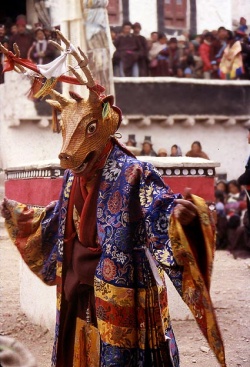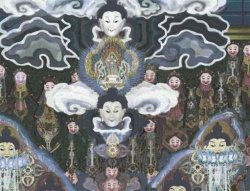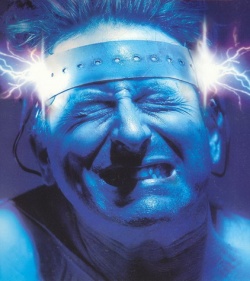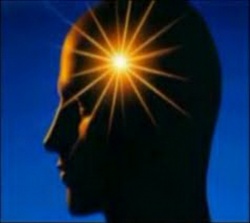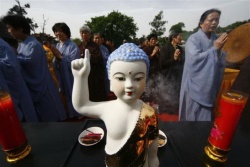Subtle bodies, higher worlds by Frank Visser
In one of his more metaphysical moments, Wilber speculates on the nature of subtle bodies and even higher realms of being. Summarizing the insights of the Vajrayana/Vedanta schools, he gives us the following diagram[1]:
| STATE OF CONSCIOUSNESS | LEVEL/STAGE/SHEATH OF CONSCIOUSNESS | BODY-ENERGY/REALM |
|---|---|---|
| Deep Sleep | Ananda-maya-kosha | Causal body |
| Dreaming | Vijnana-maya-kosha |
Subtle Body |
| Waking | Anna-mayakosha | Gross Body |
Commenting on it, he writes:
- Forgive me for repeating myself, but the staggering brilliance of this scheme continues to just floor me. There are no other models even remotely like it in its explanatory capacities, and I have incorporated those aspects, virtually unchanged, in my own model of Integral Psychology. Needless to say, modern research allows us to complexify this basic scheme enourmously -- we now recognize at least 12 (or more) major levels/stages of consciousness, which exist in at least two dozen different developmental lines, none of which are covered by the Vedanta/Vajrayana model. But the extraordinary breakthrough insights are all contained in these pioneering discoveries.[2]
His interpretation of this diagrams gives us the following picture. The three natural states of waking, dreaming and deep sleep give us access to three major "realms of being": the gross world of physical objects, the subtle world of thoughts and dreams, and the causal world of formless emptiness. Especially the subtle state is interesting, for it contains many levels or stages of consciousness: the vital-emotional level of prana, the mental level (mano = mind) and the level of the higher mind (vijnana = discrimination). For that reason, in dream we can experience both the mundane and the spiritual. The subtle states of consciousness are not confined to the dream state, however, for we can meditate, daydream, contemplate during waking life, and access the subtle levels. The physical world of objects is disclosed to us by the "food-body" (anna = food). The blissfull world of deep sleep is "disclosed" by the "body-of-bliss" (ananda = bliss).
The Great Nest of Worlds
Esoteric traditions such as Theosophy have a more refined model of subtle bodies and higher worlds. It turns out even the five "sheaths of consciousness" or koshas correspond in an intimate way to levels of being, called "planes of Nature" in these traditions. We move from the psychological to the cosmological when we try to understand these teachings, for the esoteric tradition holds the physical world to be the lowest of a whole range of higher worlds.
Isn't that a very premodern notion we should do away with? Hasn't modern science conclusively demonstrated only the physical world is real, hence our great admiration for science and its findings? Huston Smith, in his Forgotten Truth, exposes this line of reasoning as "misreading of science"[3], giving rise to "scientism". Science has limited its focus to what can be seen with the physical senses, and cannot proclaim anything about what falls outside of its limited domain. So the idea of higher worlds is not such much unscientific as it is non-scientific, as long as we rely on physics as our sole source of information about reality. Luckily we have more sources at our disposal: first of all our own inner world of thoughts and dreams, which seems to defy any explanation in terms of physics or neuroscience, and second the more remote world of extrasensory perception or clairvoyance, which has given rise to a voluminous literature on subtle energy, subtle bodies, higher worlds, chacras, life after death, reincarnation, etc. -- subjects Wilber occasionally touches upon.
Let's explore that esoteric world for a moment, to see where it brings us and where it differs from what Wilber writes about these subjects. In Theosophy, the level of Life or prana is still seen as a physical level, since it is part of this life and this body only. It is vitality that makes our body a living entity and not a dead corpse. Note that emotionality does not belong to this level, strictly speaking (Wilber often gives "emotional-sexual" as the meaning of "pranic", which is only partly true. Emotionality is a realm of its own, sexuality is indeed closely related to the physical body and to breathing)[4]. The mano-maya level is differentiated into two separate realms: the astral or emotional world and the mental world -- together they form the lower-mental level.
The astral world is seen as the first major level beyond the physical world. Its is the world of feelings and emotions, in all their complexity. It is also the world of those who have died and left their physical bodies. It can be observed an investigated by those who have activated their "astral senses", making them psychics or clairvoyants. The classic example of this type of research is The Astral Plane written by C.W. Leadbeater around 1900.[5] Like the aura or astral body of man is seen to extend beyond the physical body, the astral world is seen as extending beyond the boundaries of the earth's surface. The Great Nest of Being, pictured by Wilber as concentric circles, might very well be closer to the truth then we might suspect. The higher worlds encompass our earth with ever wider and wider circles, until the earthly dimensions are left altogether. Is this objectionable or even shocking to the modern mind? Are our deceased relatives THAT close to us? Yes, for in the Theosophical metaphysics, the higher planes are not in a domain far removed from the known world, they are seen as interpenetrating and encompassing our everyday world. (The analogy with our own emotions is helpful here: though we can never see and touch our own emotions, they are very, very close to us indeed. It is safe to see they occupy the SAME space as our physical body, though they can never be reduced to it. At least thats how we phenomenologically feel them to be.).
The mental or "heaven-world" is the next world in the sequence of spheres. It is the world of our (concrete) thoughts, and also of those individuals in the afterlife who have "moved on" from the astral to the mental world. (In this theory, the astral world can very well be compary to Purgatory of Catholicism; the mental world if the heaven world proper -- just to reassure you: eternal hell just did not turn out to exist ;-). Although emotions and concrete thoughts are very much intertwined during earthly life, ontologically they belong to separate levels. This is corroborated by our own experience: emotions "feel" different from thoughts, they are more like water, as thoughts are like air. Emotions can really move us into action; thoughts work different, they make us passive and introspective ("absent minded"). In the Theosophical view of the afterlife, we spend some time on the astral plane (day, months, years or even centuries) to purify our emotions, let go of earthly attachment and do some soul searching. This is inevitably followed by time spent on the mental plane or heaven world, were we can see our thoughts as clearly as we see objects in the physical world.
The heavenly period comes to an end when the next level is reached: that of the vijnana or higher mind. (Note: this level is called "causal" by Theosophists, for it turns out to be the level of the reincarnating Self, in its higher mental aspect (manas). Note also that this differs from Huston Smith's view given in Forgotten Truth, were Mind relates to teh Intermediate world, and Soul to the Celestial world[6] - in Theosophy both the intermediate astral and the heavenly mental world are seen as existing within the domain of the mind.
Beyond the higher mental or causal world is the world of buddhi or intuition, which is touched only by the spiritually awakened. The Buddhic sheath or body can no longer be called a "body" as we know if, for it is mor like radiating light. The causal body does have a form, though, although it is described as a delicate ovoid form: "It is difficult to describe a causal body fully, because the senses belonging to the causal world are altogether different from and higher then those we employ at the physical level. Such memory of the appearance of a causal body, as it is possible for a clairvoyant to bring into his physical brain, represents it as ovoid, that being, in fact, the shape of all the higher bodies, and as surrounding the physical body of the man, extending to a distance of about 18 inches from the surface of the physical body."[7] The causal body of an undeveloped man is merely a transparant bubble, but as he develops: "it gradually becomes a sphere filled with matter of the most lovely and delicate hues, an object beautiful beyond all conception. [8] Normally, we descend into incarnation again from the causal plane, taking up a mental, an astral and a physical body respectively.
The Theosophical correlations between subtle bodies and planes of Nature are given below:
| SUBTLE BODY | HIGHER WORLD |
|---|---|
Buddhic "body" |
Buddhic plane |
Causal body |
Causal plane |
Mental body |
Heaven world |
Astral body |
Astral plane |
| Vital body Physical body |
Etheric plane Physical plane |
In Wilber's terminology, every mind has a (subtle) body, so there is a causal body-mind, a subtle body-mind and a gross body-mind.[9] The various types of mind fit perfectly in the Upper Left quadrant, but what about the subtler bodies? Or subtle energy as such for that matter? Wilber places these in the Upper Right quadrant, naturally, because they are the outer expressions of inner states. But this Upper Right quadrant traditionally is occupied by the human brain and its various structures. Obviously something is wrong here, for the subtle bodies don't grow out of brain structures, they are of a different order altogether. This refers to the problematic question of whether the Upper Right quadrant allows for levels of being. In most popular presentations Wilber mentions brain structures or neurological research in the context of this Upper Right quadrant, so gives it a physicalist interpretation. This seems fair, because the Upper Right quadrant consists of everything we can see with our senses of an individual organism (i.e. its body and brain).
In his seminal online paper "Waves, Streams, States and Self" Wilber does seem to allow for levels in the Upper Right quadrant, though. This is a relevant remark we find in an end note:
- Note 7. In my own system, the "body/energy" component is the Upper-Right quadrant, and the "mind/consciousness" component is the Upper-Left quadrant. The integral model I am suggesting therefore explicitly includes a corresponding subtle energy at every level of consciousness across the entire spectrum (gross to subtle to causal or matter to body to mind to soul to spirit). Critics have often missed this aspect of my model because the typical four-quadrant diagram shows only the gross body in the Upper-Right quadrant, but that is only a simplified summary of the full model presented in my work.[10]
In all fairness to these critics, I would add the "typical four-quadrant diagram" is exactly the one that Wilber has presented throughout his work[11]. Does the Upper Right quadrant have any real levels? That depends on how we define it. If we define it as everything we can see objectively of an individual using the physical senses, the UR quadrant if filled with gross matter alone -- in levels of complexity, for sure, but not in any ontological sense. If we define it as everything we can see objectively of an individual using interpretation, the UR quadrant is filled with types of behavior: selfish, etnocentric, worldcentric, compassionate -- but these reflect inner levels or stages of development. If we define it as everything we can see objectively of an individual using clairvoyance, the UR quadrant would be filled with all our bodies, gross, subtle and causal. That would make the four quadrants truly Kosmic in nature.
| UPPER LEFT | UPPER RIGHT |
|---|---|
causal mind |
causal body |
subtle mind |
subtle body |
gross mind |
gross body |
| Gross body-mind, subtle body-mind and causal body-mind in the two Upper Kosmic Quadrants. | |
Vehicles of Consciousness
The definitive study of the topic of subtle corporeality has been written by the Dutch philosopher J.J. Poortman (1896-1970) in the fifties. It appeared in an English edition under the title: Vehicles of Consciousness [12]. Poortman was Professor of metaphysics "in the spirit of Theosophy" at the Leiden Univesity and a life long member of the Theosophical Society. His magnum opus Twofold Subjectivity (1929) (a Western form of Vedanta) was written at quite an early age. Poortman explored the doctrine of the subtle body from a historical, anthropological, phenomenological and philosophical point of view. As a Theosophist he had what he called a "positive prejudice" towards the paranormal and occult, but in his philosophical writings he tried to find out what metaphysical backgrounds have been used in history to explain this phenomenon of subtle materiality.
Poortman coined many new terms needed to describe this unfamilar territory. "Hylic pluralism" was his term for the graded nature of reality, seen from an objective point of view. "Noic monism" was his term for the spiritual Unity behind this manifold manifestation. Philosophically, his view was a "wider realism", within an "deeper idealism". Normally the realism/idealism debate only centers around the nature of the visible world around us. Is the world "really there?", or is it "just a thought?". Poortman was a realist when it came to the world around us -- and all higher, subtler worlds -- but an idealist when it came to the One Reality behind all this. Reality was, so to speak, not our thought but God's Thought. Reality was not created by our self, but by the Self, which explained the title of his main work.
Poortman distinguished three levels of subtle matter or "pneuma" (the Greek word for "spirit", which historically covers many levels): physiological, psychological and sublime. Vitality or the prana level is an example of physiological pneuma; the subtle level is an example of psychological pneuma, and his causal level is an example of sublime pneuma. But when L-fields (life fields) or M-fiedls (mind fields) are detected by physical means, this would be an example of physical pneuma. Physical evidence for subtle or causal phenomena is simply not possible; we can only detect physical correlates of these phenomena if our instruments are of a physical nature.
Furthermore, he distinguished half a dozen metaphysical standpoints in which historically ideas about subtle bodies have been found:
- Alpha standpoint: monistic materialism (modern science)
- Betha standpoint: dualistic materialism: gross and subtle matter (Greek philosophers)
- Gamma standpoint: gross matter, subtle matter and the One Spirit (Vedanta, Theosophy)
- Delta standpoint: gross matter, subtle matter, individual spirits and the One Spirit (Samkhya)
- Epsilon standpoint: gross material body and immaterial soul. (Descartes, Aquinas, Kant)
- Zeta standpoint: psychical or spiritual monisme, idealism (Heymans, Berkeley)
There are many interesting points of affinity between Wilber and Poortman's philosophy. Here are a few:
- A deep admiration for Plotinus and the Vedanta.
- A rare combination of rationality and spirituality.
- The centrality of the I-I experience, as our contact with the Absolute/One.
- A pervasive "knowledge-optimism": everyting below the One can be known.
- An aversion to the physics-and-mysticism craze: God is not an atom or a quantum field.
- A solution to the mind-body problem based on mystical experience of the Self.
- An integration of the different fields of science and the humanities.
- A positive interest in the sciences of the paranormal or the transpersonal.
A major difference between the two authors is that Wilber stays within the bounds of psychology, even if extended to the transpersonal/spiritual, but avoids any ontological speculations, where Poortman fully includes these in his system of philosophy. When Wilber speaks of "body/energy/realm", he never commits to the precise nature of these realms. Even his notion of "subtle bodies" lacks objectivity, for example when it is interpretated as "dream-body". Poortman did explicitly acknowledge the necessity to think about this "cosmic pluralism" or the existence of worlds, spheres, planes or realms in the Kosmos. He even believed in the possibility of a "science of the hereafter" -- at least in theory, and as of now still imperfectly realized -- when findings from clairvoyant research were used.
At the end of his "Subtle Energy" paper Wilber adds a hypothesis that would allow for some metaphysical element in his system. The first three are non-metaphysical:
- Increasing evolution brings increasing complexity of gross form.
- Increasing complexity of [gross? FV] form is (in the UR) correlated with increasing interior consciousness (in the UL)
- Increasing complexity of gross form is correlated with increasingly subtlety of energies.
Summarizing the last point, Wilber writes:
- "Thus, instead of interpreting higher levels as being essentially divorced from gross matter or gross form, the complexification of gross form is the vehicle of manifestation for both subtler energies and greater consciousness."
A materialist, following the Alpha standpoint mentioned above, would not object to these three postulates: a complex brain correlates with complex consciousness and with any other forms of "subtle energy" that can be detected with physical means. However, the phrase "vehicle of manifestation" already dangerously close to a metaphysical point of view. When Wilber adds his fourth postulate, to explicitly make room for the idea that consciousness can survive the death of the physical body, he formulates this as follows:
- Complexity of gross form is necessary for the expression or manifestation of both higher consciousness and subtler energy.
We should be very careful here. Both Wilber's summary of postulates #1-#3 and postulate #4 use the phrase "vehicle of manifestation", one in a non-metaphysical sense, one in a metaphysical sense. So in a post-metaphysical view, the body is a vehicle we can never leave; in a metaphysical view the body is a vehicle we can leave? The metaphysical view would add: the body is necessary for consciousness to express itself on the physical plane, but it is not its sufficient cause. If we are a spirit after death we are a spirit while living, and neither brain nor gross body can account for the fact of consciousness while we are alive either. The use of the world "correlates" in the three postulates (or some equivalent) makes the point of view non-metaphysical, for it just avoids the question of what comes first: body/brain or consciousness. In postulate #4, what is meant is that consciousness is primary: it can either manifest itself on the physical plane through a physical body, or it can live on its own plane.
Paraphrasing Varela's book title The Embodied Mind -- which according to Wilber avoids the metaphysical question altogether -- any book what could accurately describe these body/mind relations would have to be called The Incarnated Mind.
Source
- ↑ Ken Wilber, Towards a Comprehensive Theory of Subtle Energies, Except G, wilber.shambhala.com
- ↑ Ken Wilber, Towards a Comprehensive Theory of Subtle Energies, Except G, wilber.shambhala.com
- ↑ Huston Smith, Forgotten Truth: The Primordial Tradition, Harper & Row, 1976, p. x.
- ↑ Likewise Sri Aurobindo speak of the levels of Matter, Life and Mind, which can tempt us to put emotionality in the Vital category, if Mind is understood in more mental terms. In Theosophy Life refers to the vital level proper, and emotionality is seen as an independent, astral level of being.
- ↑ C.W. Leadbeater, The Astral Plane, its Scenery, Inhabitants, and Phenomena, Theosophical Publishing Society, London, 1895.
- ↑ Huston Smith, Ibid., p. 62.
- ↑ A.E. Powell, The Causal Body and the Ego, Theosophical Publishing House, 1928, p. 94. (Chapter XVI. Composition and Structure).
- ↑ Ibid, p. 95.
- ↑ Excerpt G.
- ↑ K. Wilber, Waves, Streams, States and Self: A Summary of My Psychological Model, wilber.shambhala.com
- ↑ We find the following as occupying the Upper-Right quadrant: Sex, Ecology, Spirituality: atoms, molecules, cells, brain structures; A Brief History of Everything: behavior, empiricism, positivism, physics, neurology; The Eye of Spirit: atoms, molecules, cells, brain structures; Integral Psychology: atoms, molecules, cells, brain structures behavior, matter -- not a hint of higher level subtle energies, only "levels of complexity", which are pseudo-levels without ontological significance.
- ↑ J.J. Poortman, Vehicles of Consciousness, 4 vols., Theosophical Publishing House in the Netherlands, 1978. Original title: Ochêma, 1954. In 1993 a valuable (Dutch) follow up study appeared as The Vehicle of the Soul (Ankh-Hermes), written by Hein van Dongen and Hans Gerding (the current Professor of metaphysics at Leiden University).
